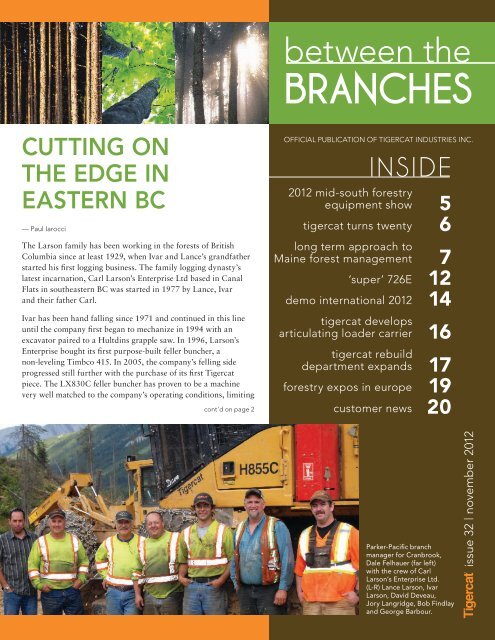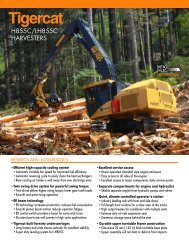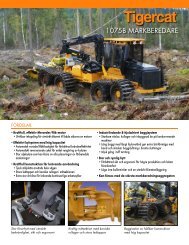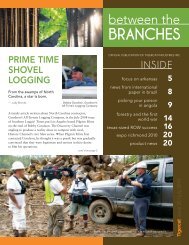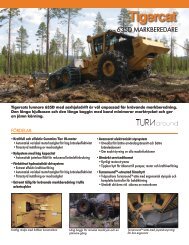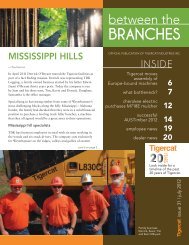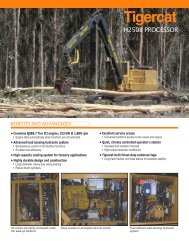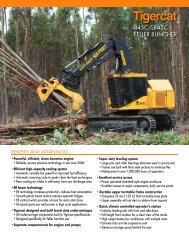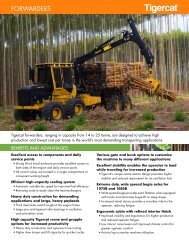Download PDF - Tigercat Industries Inc.
Download PDF - Tigercat Industries Inc.
Download PDF - Tigercat Industries Inc.
Create successful ePaper yourself
Turn your PDF publications into a flip-book with our unique Google optimized e-Paper software.
etween theBRANCHESCUTTING ONTHE EDGE INEASTERN BC— Paul IarocciThe Larson family has been working in the forests of BritishColumbia since at least 1929, when Ivar and Lance’s grandfatherstarted his first logging business. The family logging dynasty’slatest incarnation, Carl Larson’s Enterprise Ltd based in CanalFlats in southeastern BC was started in 1977 by Lance, Ivarand their father Carl.Ivar has been hand falling since 1971 and continued in this lineuntil the company first began to mechanize in 1994 with anexcavator paired to a Hultdins grapple saw. In 1996, Larson’sEnterprise bought its first purpose-built feller buncher, anon-leveling Timbco 415. In 2005, the company’s felling sideprogressed still further with the purchase of its first <strong>Tigercat</strong>piece. The LX830C feller buncher has proven to be a machinevery well matched to the company’s operating conditions, limitingcont’d on page 2OFFICIAL PUBLICATION OF TIGERCAT INDUSTRIES INC.INSIDE2012 mid-south forestryequipment show 5tigercat turns twenty 6long term approach toMaine forest management 7‘super’ 726E 12demo international 2012 14tigercat developsarticulating loader carrier 16tigercat rebuilddepartment expands 17forestry expos in europe 19customer news 20Parker-Pacific branchmanager for Cranbrook,Dale Felhauer (far left)with the crew of CarlLarson’s Enterprise Ltd.(L-R) Lance Larson, IvarLarson, David Deveau,Jory Langridge, Bob Findlayand George Barbour.issue 32 | november 2012
cont’d from page 1Ivar’s hand falling duties to the occasional steepdrop-off or rock ledge.The Larsons deal with Parker-Pacific, Cranbrook fortheir <strong>Tigercat</strong> machines and have recently purchased asecond LX830C, finding it to be an optimal machinefor the area. It is equipped with a 5702 saw with ahigh rotation wrist, which helps build better skidderbunches with less travel. Observing the machinein action, it is obvious that the carrier and sawcombination handle the wide variety of tree sizes well.duties around the congested and busy roadsidelandings, which are often size constrainedby challenging site topography.The annual production is achieved in four ten-hourshifts and a single eight-hour shift per week withspring break-up lasting approximately one month.There are generally four sorts — spruce, balsam,larch and pine — and daily production is range boundbetween ten and fourteen 50 m 3 (approximately55 ton) loads. Ivar intimates that Canfor is dulyimpressed with the productionthat the Larsons can squeezeout of a five-man crew andoffers a clue to the company’ssuccess. “The guys are themost important part of ouroperation… We are taking thewhole crew on a fishing trip.I told them, ‘You are goingbecause you are doing a goodjob for us.’ They are why weget 150 000 metres with acrew of five.”Jory Langridge builds a bunch on a steep hillside. Between travelling up the hills in reverse,building bunches and sorting and decking, he spends a lot of time in the rear facing position.The machine bunches smaller stems effectively andcan easily handle the half cubic metre (approximatelyhalf ton) stems at the larger end of the scale. The zerotail-swing provides additional leveling capability overa full tail-swing machine and increased agility for theoccasional selective cut.These days Larson’s Enterprise produces for Canfor,operating on an annual volume of 150 000 cubicmetres of tree-length timber with a crew of five. BobFindlay operates the new LX830C feller buncher.George Barbour and Jory Langridge run E620C and630D skidders respectively. At roadside is a <strong>Tigercat</strong>H855C processing four or five tree-length sorts. Ivarhops on the loader to perform sorting and decking2 | between the BRANCHESOf course the song neverremains the same and withCanfor’s recent expansioninto the east Kootenays, theLarsons are currently in themidst of a transition to shortwood. Their initial attemptresulted in a 30% reduction inprocessor productivity but Ivarand Lance expect that number to improve. However,the high number of sorts combined with the shortwood directive will likely result in a requirement foradditional processing capacity.Ivar comments on his purpose-built roadside machine,which is priced higher than the typical convertedexcavator: “I like the H855C. It can buck more thanan excavator. Some people don’t believe me and thatis just fine with us. It gives us an advantage. I also likethat it is made in Canada. It’s like it’s ours.”One unique aspect of the operation is the degree towhich the skidders are contributing to the deckingand sorting functions. Jory Langridge is taking fulladvantage of the Turnaround feature to help with
cont’d from page 3The E620C pulling downhill in steep terrain.He also appreciates the balance between the powerand stability of the machine. “The 630D can pullmore than other skidders without standing up thefront end or running out of power or heating up. Itnever hesitates or bogs down when pulling out of abottom.” He also comments on the precision of theelectronic-hydrostatic drive system. “You can adjustyour trim so that you can move an inch — it caninch up a hill.”Singing praise for TurnaroundAlthough George’s E620C is notTurnaround equipped, Jory’s is, and heuses the feature to its fullest potential.“When backing up the hill, it allows youto look at the lay of the land and pick yourpath. You can see roots and stumps,” hesays. “After a ten-hour day, I feel so muchbetter. I would go mining before I wentback to a skidder without a Turnaroundseat. There is nothing else like it.”For someone who has only operatedconventional skidders, Turnaround mightat first seem to be a radical departure: theoperator has one drive pedal at the frontof the cab and one pedal at the rear ofthe cab. Forget forward and reverse – adirection selection switch on the joystickdetermines if the machine will travel bladefirstor grapple-first. The computer system4 | between the BRANCHESautomatically adjusts the controls based on whichdirection the seat is facing, so when the operator isfacing rear, and selects ‘forward’ direction, he willtravel grapple first. (The joystick steering operatesthe same way.)Asked to comment on the learning curve, Joryresponds, “It only took a week to feel right at homewith it. The joysticks were not an issue at all becauseI’ve run excavators before.” Now with 1 300 hoursof seat time under his belt, Jory is doing some prettyinnovative stuff with Turnaround.The H855C processing long lengths in 0,34 m 3 average piece size.
<strong>Tigercat</strong> Turns Twenty<strong>Tigercat</strong> celebrated its 20th year in business over thedays of June 21-22. Formal events included factorytours, a dinner and party for 1,300 guests as well asthe premiere screening of ‘20’, a new film by <strong>Tigercat</strong>that tracks in super high definition the beginningsof the company, some of the challenges faced, andwhat the <strong>Tigercat</strong> brand means today to customersthroughout the world.Guest speakers at the dinner events included BobbyGoodson of Swamp Loggers fame and prominentsouthern US loggers, Joseph Parnell and CharlesJohns. <strong>Tigercat</strong> also took the opportunity toacknowledge the retirement of Joe Kemp, branchmanager for B&G Equipment, Magnolia. Joe hasbeen a dedicated manager and tireless proponent of<strong>Tigercat</strong> machinery for nearly twenty years and B&G,which took on the <strong>Tigercat</strong> line in 1993, is the longestrunning <strong>Tigercat</strong> dealer.<strong>Tigercat</strong> began in 1992 when a small group ofprofessionals with extensive experience in the loggingequipment industry teamed up with the Cambridge,Ontario based fabrication company, MacDonaldDonnie Lambert, Heyward Moore, Marty Lambert and <strong>Tigercat</strong>president, Tony Iarocci. The Lamberts participated in the film, ‘20’.Steel. Extensive field research determined that theperformance of drive-to-tree feller bunchers wasfalling short of the expectations of loggers. <strong>Tigercat</strong>set out to design a technically superior alternative.The result was the 726 feller buncher.Now twenty years later the company has achievedwhat few thought was possible. <strong>Tigercat</strong> is at theforefront of the evolution of harvesting equipment andthe product offering has grown to nearly 50 carriersand attachments. None of this would be possiblewithout the dedication of the <strong>Tigercat</strong> team, thepartnerships forged with dealers and suppliers andthe support and feedback from <strong>Tigercat</strong> ownersand operators.Order your copy of ‘20’ on Blu Ray or DVD atwww.tigercat.comPieter de Wet and Mark Wells from PG Bison inSouth Africa who participated in the film, ‘20’.6 | between the BRANCHES<strong>Tigercat</strong> CEO, Ken MacDonald, deliveredthe closing remarks at the gala event.
cont’d from page 7A 630D or 635D skidder hauls to the processor. The machines are equipped with GIS technology which maps thefelling corridors and helps the skidders to maintain a steady flow of wood to the processor.corporate members – is a member of the CooperativeForest Research Unit (CFRU) at the University ofMaine in Orono. Areas of research pursued in thepast few years include assessing the risk and impactof future spruce budworm outbreaks in Maine forestsand strategies for improving hardwood regeneration,among many other topics addressing important forestsustainability issues in the state.The company’s forest practices are audited byindependent experts in accordance with principlesof the Forest Stewardship Council (FSC) and theSustainable Forestry Initiative (SFI). “Certificationis about accountability. Don’t take our word forit, consider the rigorous independent review by theexperts to ensure that forestlands are promptlyregenerated and measures are taken to protectwater quality, wildlife habitat and species at risk,”says Peter.Irving’s silviculture program includes a nursery whichproduces 25 million trees per year and an extensivestock and seedling research division. The companyhas recently discovered a naturally occurring spore inspruce trees that makes them more resistant to sprucebudworm. A patent is pending for this innovation.Irving’s total annual harvest in Maine is one milliontons “in a region where wood costs are not low,”explains Peter. This is where things get interesting. Inorder to compete against low cost offshore hardwoodchips, Irving has placed an incredible focus on costsavingefficiencies across every function and level of itsforestry operations without sacrificing the integrity ofthe land and forests or the quality of the product.Wide, straight roads are an Irving hallmark and largepayload off-highway transport is key to reducing fibre costs.8 | between the BRANCHESKey to the entire woodlands operation is cost effectivetransportation. Irving invested in a chip handling yardwith rail spurs in 2006 that connects its woodlandsto the mill in Saint John, New Brunswick. A daunting320 km (200 mi) jaunt on the highway, Peter explainsthat “rail brings you a hundred miles closer.”
In combination with the railsiding in Ashland, Irving makesextensive use of off-highwaytruck transport, using theintricate network of legacy andnewly constructed forest roads tomove fibre from the harvestingsites to the Ashland yard withouttravelling over a single pavedkilometre. Hardwood logs, longlength softwood pulp and chipsall come into the yard on offhighwaytrucks and ship out byrail. Operations superintendent,Josh Philbrook, says that thegreater payloads made possiblewith off-highway transportrepresent a 20% savings overregular highway trucking.Specially designed chip vans carry 60 ton loads (1 tonequals approximately 900 kg). To take full advantage,Irving constructed a special chip dumper in 2006 thatThe H822C merchandizes high value logs, prepares trees for the chipperand sorts maple and mixed hardwood in indexed piles.can lift truck and trailer, reducing the unload timeby fifteen minutes because the trailer does not haveto be detached.cont’d on page 10THERE ARE NO LIMITS FOR OPERATORS WITH THE RIGHT TRACKS.OLOFSFORS OFFERS A WIDE RANGE OF TRACK MODELS AND LINKAGE SYSTEMSFOR VARIOUS MACHINE CONFIGURATIONS AND GROUND CONDITIONS.ECO-TRACKS, THE NAME YOU CAN TRUST!www.eco-tracks.comECO-Tracks and ECO-Wheel Tracks are trademarks of Olofsfors ABbetween the BRANCHES | 9
cont’d from page 9In a bid to further whittle away at transportationcosts, Irving builds or rebuilds 160 km (100 mi) offorest road annually. “An Irving trademark is highquality, straight roads — for safety and efficiency,”Josh asserts. The focus is on wide, straight roads withas much visibility as possible to increase the averagespeed of the hauling trucks.Irving sets up, finances and trains owner-operatorcontractors, the majority of which own a singlemachine rather than a whole system. Contractorswork together and the typical system combines a fellerbuncher and skidder for initial extraction. Irving ispartial to 822C feller bunchers for the mostly selectivecut operations. The skidder — either a 630D or 635Ddepending on optimal drag size, skid distance andrequired flotation — pulls to a box at roadside wherean H822C harvester processes and sorts softwood,mixed hardwood and maple, cutting saw logs andvaluable veneer logs before “prepping” the hardwoodpulp by busting up (but not removing) the limbs sothat the trees can be fed into and digested by thechipper more easily.The high-value hardwood logs are short hauled bythe skidder and decked closest to the road and thesoftwood is swung around behind the harvestertoward the road. Once the processor is finished, andthe logs and softwood have been hauled away, a630D skidder and a chipper come in. What remainsare two or three extended decks of tree-length or neartree-length hardwood pulp. The maple is on top andindexed about three metres behind and underneathis the mixed hardwood sort. “The skidder can pulloff the top to the chipper without disturbing the sortunderneath,” explains Josh.These sorting, merchandising and chipper preparationfunctions used to be accomplished with strokedelimbers and slashers. The H822C harvestersequipped with Waratah heads are more efficient —doing a better job of sorting and indexing, achievingbetter utilization by cutting more high value logs – allwhile eliminating a machine.To help the skidder balance distances, optimize forday and night shifts and keep the processor well fed,Irving has developed its own in-house GIS system.At the end of each shift, all the data related to thecutting activity of the feller buncher is downloadedto the skidder. Through the in-cab interface, theskidder operator at a glance can see the feller bunchertrails and related distances and topography. “He canlook at the whole block and understand it to be moreefficient,” comments Peter.Another area of focus is data collection. Irving goesbeyond tracking machine productivity and inputcosts. Machine downtime is carefully broken downand categorized. When a machine is idle — even for ashort period of time — the operator must input one often stop codes. Analyzing this data is very beneficialin determining which way to tweak best practices tocreate the most balance and throughput.Placing great emphasis on continuous improvement,Irving has Sigma-6 trained employees like DanaJohnston on staff completely focused on processimprovement initiatives. Dana explains that they haveworked out hourly productivity requirements for theskidder by analyzing the twitch size, distance anddrive speed achievable for a given block. “The dayshift operator might mix and match — bring threeWith a rail siding at the Ashland yard, the Maine operations make extensive use of rail for transporting chips and round wood.10 | between the BRANCHES
short skids in and then go for a long one,” says Dana.Generally the night shift operators will stick to thelonger trails where they can be more efficient.The skidder operators will also try to equalize skiddistances and times by pulling outlying twitches to theclosest corner of the block and short distance twitchesto the further corners. The skidders target six tontwitches but the payload can drop as low as 3.5 tons.The operators must strike a balance between the loadsize and the time it takes the skidder to acquire theload. The number of sorts and the volume and densityof the block can significantly constrain payload. “Ifthe skidder has to stop four times, it might be betterto bring in smaller twitches or have the buncher sortor build bigger bunches, knowing it is going to affectthese guys downstream,” comments Peter.The chipping sides work two twelve-hour shifts, fivedays per week, producing an average of 3,000 tons perweek. Irving made the transition to in-field chipping in2006. Previously, pulpwood was processed in randomlengths and transported as round wood.In-field chipping results in 15% more chip volumeright off the top because the large branches and topsget chipped as well. Higher recovery rates are not theonly advantage. The process is also less expensive.The downside? Slightly higher bark content and twopercent oversize chips which are screened out furtherdownstream. But as Peter says, “We are integrated, sowe can make it work.”In-field chipping has other advantages — especiallyto a company as vertically integrated as Irving. Themore processing that can be done close to the stump,the better, according to Josh and Peter, because thisultimately decreases handling and transportation costsdownstream and ensures that each product gets to theright market or mill by the most direct routing.All of Irving’s land in Maine is designated openuse and available to the public for recreationopportunities. In these matters, Irving is representedby North Maine Woods, an organization thatadministers recreation land for private landowners.It has over 1,4 million ha (3.5 million acres) underits umbrella and represents landowners varying fromlarge corporations like Irving to individuals andfamilies with relatively small parcels. Although theIrving constructed a special chip dumper that can lift truckand trailer, reducing unload times.land ownership structure is a patchwork, recreationalusers are guided by just one set of uniform regulationsand fees and do not have to obtain several permits orpay different user fees to different landowners.After touring the operations for a day, it is glaringlyapparent how much the company and employees careabout the forestland. Peter and Josh are constantlyquestioning and discussing the way things arecurrently done and discussing how various aspectsof the operations could be improved – whether theimprovements are related to production, safety,forest health or aesthetics. An obvious sense of prideand long term thinking prevails. “We are proud tolive, work and raise our families in Maine,” saysPeter. “Our everyday work in the woods is aboutsustainability — for the community, the environmentand for the economy.”For the extended article, please visit the BTB‘additional content’ section at:http://www.tigercat.com/index.php/Additional-Content/between the BRANCHES | 11
One of Howard Means’ new 726E bunchers felling 35 m (120 ft) pine in tough terrain in Chickasaw State Park.‘SUPER’ 726E<strong>Tigercat</strong> brings back the 726E fellerbuncher with a high horsepower twist.Jim Ard, owner of Jim Ard Timber <strong>Inc</strong>, a Mississippilogger and B&G Equipment customer, strolled intothe B&G Magnolia branch one day with a brilliantidea. Ard, who primarily contracts to Weyerhaeuser,generally works in mature pine and the terraintypically tends to be broken up by some steep groundthat constrains the deck areas and taxes the fellerbuncher. “We’ve got these ridges,” says Jim. “Veryrarely do we have the room to put two loaders onthe same deck. We usually can’t even get the loadersclose enough together to be fed by a single skidder. It’salmost like two little jobs in one.”The day Jim popped into the Magnolia store,president W.J. Bates as well as branch manager RedWilliamson happened to be there. Jim came right outwith it, asking the two men to figure out a way to sellhim a 300 hp 726E feller buncher. “For us the 724Edoesn’t quite do the job,” Jim explains.The 220 hp 724E is very capable in almost any wheelfeller buncher clear fell application yet its size andwheelbase still lends itself to thinning jobs whenrequired, especially when equipped with the 5500 sawwhich combines big timber control with small stembunching ability. The versatility and performance ofthe 724E had completely displaced sales of the 726Eover the last few years, and <strong>Tigercat</strong> had quietlydiscontinued production of the model, as a fellerbuncher, that is.<strong>Tigercat</strong> has been busy selling a 300 hp mulcherversion called the M726E which always has hadan optional multi-function hydraulic system andquick-attach boom adapter so that the machinecould be changed to a feller buncher in a pinchif a land clearing contractor wanted to fellmerchantable timber.(L-R) Johnny Boyd, <strong>Tigercat</strong> district manager for Alabamaand Mississippi, Red Williamson, B&G Magnolia branchmanager, Jim Ard and 726E operator David Craven.12 | between the BRANCHESThat said, granting Jim’s request wasn’t as simple asslapping a sawhead on the mulcher carrier. There wassome work involved to optimize the hydraulics for
a feller buncher application. The mulcher versionhas a very large attachment pump and a differentdrive circuit so <strong>Tigercat</strong> agreed to do the requiredback-end work and put the machine into productionif B&G would make a larger commitment to threemachines. Feeling confident about the idea, theyagreed and now, a few short months later, <strong>Tigercat</strong>has shipped ten machines and demand for theindustry’s newest, largest and most powerful fellerbuncher is expanding into other regions with bigtimber and tough terrain.Jim equipped his machine with aggressive cleat66x43-25 tires providing an optimal combination oftraction, low ground pressure and side stability. “Werun the 43 tires all year round so that the machinecan work side slopes but also covers my flotation inthe winter.”Jim is overjoyed with the performance of his newmachine. “The extra horsepower is most noticeablewhen backing uphill loaded — which in turnhelps the skidders.” The 726E has an additional127 mm (5 in) of wheelbase and is 230 mm (9 in)longer overall which augments stability and tractionon slopes when the 5702 saw is clutching a big tree.Operator David Craven routinely cuts 25 loads daily.Howard Means, owner of R.H. Logging, purchasedthe second and third of the initial three machine runfrom B&G Iuka. Working summers in ChickasawState Park in southern Tennessee, Howard’s machinesare felling a steady diet of 60 year old pine growing inHoward and operator Eddie Nunnley like the stabilityand fuel efficiency of the new 300 hp machine.The first 300 hp 726E was purchased by Jim Ard afterhe requested it from dealer B&G Equipment.very fertile soil. The 35 m (120 ft) tall trees average510-585 mm (20-23 in) diameter at the stump,weighing 1,8-2,7 tonne (4,000-6,000 lb). In addition,the hilly Tennessee country can bring slopes up to30%. “We like the extra weight in the back end,”says Howard. The state forest also has quite a bit ofoversize, top heavy hardwood. In fact, the famousTennessee whisky, Jack Daniels, is aged in whiteoak barrels made from timber that comes out ofthe region.Operator, Eddie Nunnley is also impressed with themachine, adding, “That’s probably the best cutter evermade and easy to work on.” Aside from the incredibleperformance in this most challenging application thatthe majority of the world’s harvesting professionalswould say hands-down is a job for a track buncher,Howard is seeing other significant advantages. “I’verun a bunch of 726 cutters and I’ve owned a lot of<strong>Tigercat</strong>s over the years. The new machine with thelow 1,900 rpm engine speed really has an effect onfuel consumption,” he says. “You take 400 rpm offand I think this is really going to affect engine life aswell. It still pulls down but not nearly as much as theold machine. My fuel consumption has dropped from34 L/h (9 gph) to 28 L/h (7.5 gph).”Go to the video archive at www.tigercat.com tosee a video of the 726E in action.between the BRANCHES | 13
DEMOINTERNATIONAL2012<strong>Tigercat</strong> debuts 615C skidder atsuccessful DEMO International<strong>Tigercat</strong> was in full force at Demo International2012 northwest of Quebec City from September20-22. Not only did the company bring a fullcomplement of machines including feller bunchers,harvesters, skidders, forwarders, the 480 mulcherand the 880 logger, <strong>Tigercat</strong> also debuted an all-newmachine and brought over 100 team members fromall facets of the company.<strong>Tigercat</strong> employees interacted with customers and<strong>Tigercat</strong> dealer personnel from across Canada, the<strong>Tigercat</strong> debuted the new 615C, a smaller six-wheel skidder. Withexcellent traction, high performance in tough terrain and a smoothride, it comes in a compact package compared with the 635D andis suited to lower volumes and selective cut applications.northeastern US, Australia, New Zealand, SouthAfrica, Russia, Chile, Brazil, Ecuador, French Guianaand Scotland. In addition, Bobby Goodson was onsite talking to fans and signing autographs throughoutthe event.<strong>Tigercat</strong> H845C harvester equipped with aLogmax 7000XT headThe 880 logger attracted a lot of attention.The H855C harvester equipped with <strong>Tigercat</strong>’sTH575 harvesting head processed hardwood.14 | between the BRANCHES<strong>Tigercat</strong> demonstrated the FC5185bar saw on the hardwood side.
The live demonstrations consisted of two separateapplications, a softwood clear fell and a hardwoodpartial cut. On the softwood side, the felling wasaccomplished with a <strong>Tigercat</strong> H845C harvester andforwarded to roadside with the 20-tonne capacity1075B forwarder.On the hardwood side, an 822C equipped with<strong>Tigercat</strong>’s new FC5185 bar saw felled. A 630D skidderpulled to roadside where the wood was processedwith an H855C harvester equipped with <strong>Tigercat</strong>’sTH575 harvesting head. <strong>Tigercat</strong> also pulled full treehardwood to a CBI flail/chipper that was equippedwith the <strong>Tigercat</strong> 215 loader.can now have all the advantages of a six-wheel driveskidder – excellent traction, high performance in steepand soft terrain and a smoother ride – in a compactpackage with a lower purchase price. And what willbe most shocking to contractors is the drive speed.<strong>Tigercat</strong> will be reporting more on the speed andperformance of the 615C after it hits the field.Of the static machines, the big 880 logger and 480mulcher received a lot of attention but all eyes wereon the prototype 615C six-wheel drive skidder.The 615C fills a real void in the marketplace. Forcontractors with lower volumes or extremely tightand challenging partial cuts, a 635D is just not theright machine for the job. With the 615C, contractorsAttendance at the <strong>Tigercat</strong> stand was excellentduring the three-day event.Setting theIndustry Standards1-877-FAEUSA-1 * 770-407-2014 * info@faeusa.comFAEUSA.COMbetween the BRANCHES | 15
AC16<strong>Tigercat</strong> DevelopsArticulating Loader CarrierObserving a void in the marketplace as equipmentmanufacturers have for the most part stoppedproducing and supporting steering axle equippedself-propelled loaders for mill yard applications,<strong>Tigercat</strong> has stepped up with the newlydesigned AC16 articulating carrier. The AC16can be mated to a <strong>Tigercat</strong> 234 or 250 seriesknuckleboom loader.The prototype unit was purchased by VersoPaper Corp and is operating in a wood yard inDover-Foxcroft, Maine. Verso produces highquality coated papers and specialty products withoperations in Maine and Michigan.Yard supervisor, Kent Burden explains that Versobought the AC16 carrier along with the 250C loaderto replace Tanguay and Prentice self-propelledloaders with front axle steering. “They are extremelyexpensive and parts are becoming difficult to find tokeep the machines in service,” says Kent.Operator, Arthur Watson says that at first theyconsidered the AC16 carrier a compromise due to ageneral perception that articulating carriers are lessstable when driving over uneven ground. Wood yardscan get messy in wet weather and they are not alwaysflat even at the best of times. Dips and small hills aremagnified from the operating position of a raised cab,exaggerating the rocking effect.After a couple of weeks of operation, Arthur is muchmore comfortable with the machine. He says it getsaround the log yard pretty well. “And the access isgood. I can reach all the grease fittings easily,” saysArthur. “There is only one boom knuckle fitting thatyou need a ladder for. Visibility in the cab is good.The boom is mounted further forward than thePrentice but that is just something different to get usedto.” Arthur has no complaints regarding boom poweror performance.The yard takes in long length pulpwood, slashes it andsends it to three different Verso facilities. The typicalduty cycle is 25-30 loads per day — a combination ofloading short wood and unloading tree-length logs.The other component of the duty cycle is slashingwhich occurs on an as needed basis.The AC16 is four-wheel drive and has powerfultractive effort for towing applications. The carrier isfabricated by <strong>Tigercat</strong> and uses standard componentsthat are common to other <strong>Tigercat</strong> machines. Theaxles, brakes and transmission are common to<strong>Tigercat</strong> drive-to-tree feller bunchers. An optional logbunk is also available. The loader can be separatedfrom the carrier if required.Go to the video archive at www.tigercat.com to seea video of the AC16 and 250C loader in action.16 | between the BRANCHES
TIGERCATREBUILDDEPARTMENTEXPANDS— Brian Jonker, <strong>Tigercat</strong> parts managerTwo years ago our rebuild and partsdepartments relocated from a cramped3 250 m 2 (35,000 ft 2 ) facility in Paris intoa 7 150 m 2 (77,000 ft 2 ) building in Brantford whichallowed us the opportunity to continue to grow theparts and service portion of <strong>Tigercat</strong>’s business.Since the move, the rebuild department has expandedits workforce by 25% and increased its inspectionand rebuild production by more than 40%. The mainAll hydraulic pumps and motors are assembled in the newly constructedclean room. The environment is climate controlled and free of airborne dust.focus of the rebuild group has always been to take fulladvantage of the opportunity to evaluate componentfailures in order to help avoid them in the future.<strong>Tigercat</strong> resolves issues with component suppliersby providing information and feedback about ourfindings. In turn, this provides additional informationto <strong>Tigercat</strong>’s designers, helping them to selectcont’d on page 18Ultimate Durability800.528.3113 • sales@fecon.com • fecon.comMade in North Americabetween the BRANCHES | 17
cont’d from page 17The rebuild team. (L-R) Bill Clark, Paul Aitchison, Craig Barton, GordHilborn, Jeff Dixon, Peter Poulton, Gord MacDonald, Brad Smith,Trevor Nemeth, Doug Sabila, Paul Deruiter, Mike Howard, BobWannamaker, Carlos Hernandez, Eric Hernandez and Dino Marrocco.and specify the most reliable components for<strong>Tigercat</strong> machines.Over ten years ago we initiated the TEC Program(<strong>Tigercat</strong> Exchange Component Program). Since thenwe have rebuilt and tested over 15,000 components.All were sold with the same warranty as new.Now we are expanding into the next phase ofour growth. A second state-of-the-art test standis currently in design with hopes of having itoperational by the summer of 2014. In addition,for many reasons, we have built a dedicated cleanroom where all our hydraulic pumps and motorsare assembled. Climate controlled and free ofoutside dust and debris, the new environmentallows us to have the utmost confidence inthe rebuilt components we are providing toour customers.As we continue to evolve and grow, the oneconstant in our rebuild department has been thededicated and experienced technicians who workto produce the best quality product that befit the<strong>Tigercat</strong> brand.With the change in buildings, the upgrade in facilitiesand the strength of the rebuild team, we are confidentour customers will receive the best quality rebuiltcomponents for years to come.Every Cut.Clean.Whether you’re selective logging, skidding timber or scarifying acres of terrain, Cummins QSB6.7diesel makes <strong>Tigercat</strong> equipment run better. Our Tier 4 Interim engine uses proven Exhaust GasRecirculation (EGR) technology that’s been working in hundreds of thousands of B Series-poweredvehicles since 2010. The QSB6.7 gets up to 5% better fuel economy than the Tier 3 engine, loweringyour total cost of operation as it increases productivity. Plus, it’s backed by the biggest, most capableparts and service network in the world – with assistance at 1-800-DIESELS (1-800-343-7357).Visit cumminsengines.com to see how much better your operation can run.©2012 Cummins <strong>Inc</strong>., Box 3005, Columbus, IN 47202-3005 U.S.A.18 | between the BRANCHES
TIGERCATIN EUROPEClohse Group, <strong>Tigercat</strong>‘sWindow to the 2012Forestry Expos in Europe— Rossana Constant,international sales administratorClohse Group is the <strong>Tigercat</strong> dealer in severalEuropean countries, including Belgium, Luxembourg,Netherlands and Germany. The company, with morethan 40 years of experience in the forestry equipmentmarket originated in the village of Crombach (locatednear St. Vith) in Belgium. The founders, Dieter, Joséand Heinz Clohse, started the company out of theirextensive knowledge of the forestry business.During 2012, Clohse exhibited <strong>Tigercat</strong> equipmentat two different trade shows, Forexpo in Franceand KWF in Germany. This was the first time that<strong>Tigercat</strong> equipment was displayed at forestry showsin Europe (outside of Sweden) and I felt proud of therobust <strong>Tigercat</strong> equipment highlighted by beautifulscenery and excellent stands and displays arrangedby Clohse.Clohse Group ordered four machines to display at thetwo shows: a 1055B forwarder, 1135 wheel harvester,a Turnaround equipped 610C grapple/winch skidderand an H845C track harvester.Forexpo 2012, FranceWith support of the community of Mimizan, Forexpo,the European trade fair for forestry and logging,welcomed more than 33 000 visitors during the eventheld June 6-8, 2012. We were extremely impressed bythe amount of people stopping at our site to see ourmachines and requesting information about them.Our 610C skidder was a knockout according to theFrench loggers but all of them were requesting to seea double winch, a local preference that they are notwilling to give up. Due to the high level ofinterest, Clohse set up an extremely well attendedlive demonstration after the show. The manycontractors in attendance were very enthusiasticabout the machines.From there we moved to Germany to attend one ofthe biggest forestry equipment shows in Europe, KWF.Once again our dealer performance was first classin representing and exposing our equipment to theEuropean logging contractors.KWF Expo 2012, GermanyThe first KWF event took place in Lüneburg in 1964under the heading ‘Forest establishment - technicalpossibilities and innovative approaches.’ Until the1980s each event focused on a special topic presentedwith practical demonstrations for forest professionals.These days, KWF takes place every four years,alternating with the Interforst trade show in Munich.As visitor and exhibitor numbers continue to rise,the KWF has grown into the most important foresttechnology event in central Europe and one of thelargest forest technology trade fairs in the world andfor this we were proud to have our <strong>Tigercat</strong> equipmentintroduced to this market.This year’s KWF, held June 13-16, was composed ofthree elements – the KWF exposition, field trips andthe scientific congress. Over 400 exhibitors from 20countries presented their current developments andstate-of-the-art technology over a 100 ha (250 acre)site. The event attracted more than 53 000 visitors.<strong>Tigercat</strong> generated a great deal of local interest aswell as attention from harvesting contractors inneighbouring Austria and Denmark.If I have to describe these events in two words,I would say, total success!between the BRANCHES | 19
customer newsARRANTS LOGGING NAMED TIMBER HARVESTING’SLOGGING BUSINESS OF THE YEARUS publication, Timber Harvesting has named NorthCarolina based Arrants Logging, headed by FrankieArrants, as 2012 Logging Business of the Year.Arrants, a longtime <strong>Tigercat</strong> customer, received theprestigious award based on a combination of factorsincluding his high regard for the safety and well-beingof his employees and his high degree of integrity andprofessionalism on the job.1995 and the Forest Resource Association in 1996.Congratulations to Frankie, wife Danette, partnerMason Lilley and the entire Arrants family.Arrants cares about the land that his crews operateon. Landings are kept tidy and environmentalregulations are respected and exceeded. His effortsgo a long way in keeping landowners happy whileimproving public perception of the forestry industry.Frankie Arrants has purchased around fifteen <strong>Tigercat</strong>machines beginning with a 726 feller buncher in 1994.No stranger to attention, Arrants and his companieshave been recognized in the past by Weyerhaeuserin 1994, the North Carolina Forestry Association inImage courtesy of Hatton-Brown Publishers <strong>Inc</strong>.Congratulations to Raena Mattson, daughter ofRandy Mattson who owns Alberta-based First PassOilfield Contracting <strong>Inc</strong>. Raena recently completed ahalf marathon in Reykjavik, Iceland raising $6,610for the Canadian Diabetes Association. Her officialtime was 2:36:53. Randy, a top notch professionaland <strong>Tigercat</strong> customer, was featured in BTB inMarch 2010.From the archives: Check BTB #24, March 2010 fora profile on First Pass Oilfield Contracting.LETTERS TO THE EDITOR:E-mail: comments@tigercat.comInternet: www.tigercat.comTel: 519.753.2000Mail: P.O. Box 637, Brantford, ON Canada, N3T 5P9


